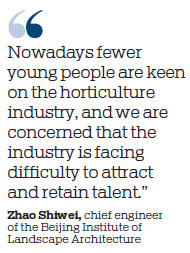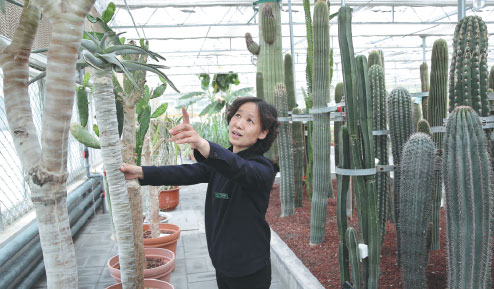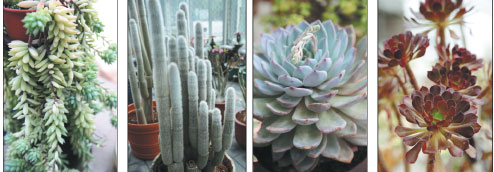PLUGGING THE GREEN DEFICIT
Small pots with succulent plants have become a craze for Chinese but horticulture sector is facing a manpower shortage
Cheng Yajing is a gardener with "magical power" to make plants grow faster in a greenhouse at the Beijing Botanical Garden, also a playground of succulent plants such as cactus, vines and potted juicy leaves.
"I've just finished trimming and fertilizing them," says Cheng, as she walks through the greenhouse covering a total area of 1,000 square meters and spells out names of various plants.
Lophophora cristata, a distinguished mutant plant with a history of more than 100 years, with hundreds of colorful hybrids, is a blast from the past, she says.
Cheng, 43, decided to conduct research on succulent plants and cultivation after she graduated from the Beijing University of Agriculture in 1998.
But she set herself the goal of becoming a professional gardener much earlier - when she was in high school.
Cheng was one of the first batch of people who started to explore the splendor of succulent plants, but she didn't expect the small pots would become a craze for millions of Chinese.
It was not until 2011 that the succulents industry in China started to boom, aided by cyber publicity.
A long-distance athlete since primary high school, Cheng has always been dedicated to things she loves, such as replacing soils and pruning messy branches in the garden. And despite being allergic to pollen, she did not give up on this career.
As leaves from the succulent plants fall, Cheng carefully collects them and grows them again in relatively good soil.
She has also traveled to the botanical gardens in South Africa several times to learn how to better take care of the plants. Over the years, she has brought back more than 1, 000 species of different succulent plants.
Aging problem
But horticulture is facing a crisis, says Cheng, as, according to her, the average age of various professionals in gardens and scenic spots is 45 and positions like groundskeepers and display workers are often left open.
Also, the demand for horticulture professionals is growing as the market has boomed in the past 10 years.
So, as plant growers reach retirement age, there are too few gardeners arriving to replace them, says Zhao Shiwei, the chief engineer of the Beijing Institute of Landscape Architecture, the only municipal public welfare landscape research institute in Beijing.
"There's an obvious gap in plant cultivation and maintenance talent in recent years, especially those who have an overall understanding of horticulture landscape designs and garden flower cultivation," he says.
Zhao also says that horticulture involves a wide range of fields, and a long period is needed to train professionals.
"More importantly, the work is relatively tedious for young professionals. Nowadays fewer young people are keen on the horticulture industry, and we are concerned that the industry is facing difficulty to attract and retain talent," he adds.

As for front-line gardeners, many of them are known as "city farmers" as they need to weed and mulch for the plants.
According to the Beijing Forestry University, the top forestry-related academic institution in China, only half of their graduates majoring in horticulture in 2018 chose to work on horticulture-related fields. And it says the percentage is declining.
Zhang Qixiang, a professor of horticulture and former vice-president of the Beijing Forestry University, says college graduates account for only 5 percent of the total number of workers employed in the garden industry.
And, he says, this is despite horticulture being closely associated with people's lives and the fact that it can be helpful in tackling environmental and social issues, including the effects of climate change, the lack of access to fresh food and extreme weather.
"On a wider scale, horticulturists should focus on the construction of national parks and development of urban green spaces," he says. "And flower decoration and home gardening are also something horticulturists should keep an eye on."
But due to the long gestation period and its overlap with agriculture, and the fact that the horticulture industry is relatively labor intensive, many undergraduates are not keen to enter the field, says Zhang.
Zhao, the chief engineer, also says that in the past 10 years, a rapid development of horticulture can be seen in China.
In the late 1980s, only three universities had garden-related majors, but now many colleges and academic institutions are offering these courses.
Market boom
According to Zhao, the boom in horticulture education is closely related to the growing market demand, especially for those who can use high technology for planting. So, a lot of gardens in Beijing are also calling for more high-skilled talent.
But the gap between jobs and takers is so obvious that the industry has gradually become polarized with undergraduates and graduates preferring to become researchers and scientists in the field working for large-scale greenhouse operations and entrepreneurs.
And, also though landscape crews and workers are often urgently needed, sometimes only rural migrant workers in the city can fill the gap.
Higher salary is another aspect that young professionals consider.
So, even as the market thrives, some companies have not raised salaries, says Zhao.
Meanwhile, the 2019 Beijing International Horticulture Expo will be a valuable opportunity for the whole industry in China to attract more horticulture talent, says Zhang Qixiang.

As an A1-level expo, the highest rank, the Beijing 2019 has attracted more than 100 countries and international organizations to participate in the event.
The 162-day expo is aimed at displaying the latest achievements in floriculture and fruit cultivation, as well as vegetable farming worldwide, and is expected to see 16 million visitors from home and abroad.
"Horticulture is the direct way to connect your life with the green lifestyle. Also, gardening at home can raise people's awareness of green protection," says Zhang.
And as many young people in China now lack a basic understanding of plants and their value, the expo will help them learn how to protect our earth, he adds.
Cheng is also a keen supporter of the expo. And she has been part of the team decorating the China Pavilion, one of the main ones in the expo garden, since January this year.
She plans to bring her daughter, who is in primary school, to the Beijing Botanical Garden during the summer vacation. "I enjoy communicating with plants at work, to make myself fully blend with the environment," she says.
xinwen@chinadaily.com.cn
|
Different varieties of succulent plants are cultivated by Cheng Yajing at the Beijing Botanical Garden.Photos By Zou Hong / China Daily |
|
Cheng Yajing, a 43-year-old gardener at Beijing Botanical Garden, points to the plant that she brought from South Africa in the greenhouse.Zou Hong / China Daily |
|
Cheng was one of the first batch of people who started to explore the splendor of succulent plants.Zou Hong / China Daily |
(China Daily 05/03/2019 page6)

















